► New 508 PSE vs S60 Polestar
► Fast PHEVs – do they work?
► Non-German options compared
Plug-in hybrids optimised for hooliganism and tax breaks? Sounds too good to be true. But Peugeot and Volvo are in the game, so let’s find out what one’s best.
Pre-flight briefing: Peugeot 508 Sport Engineered
Why is it here?
Fast Peugeots are supremely cool but the French maker is keen to remind us that its illustrious history goes way beyond the GTI hot hatches for which it’s rightly famous. This one channels the 405 T16, with loads of power, all-wheel drive and space for the family. The 508 in any form is one of the greatest comebacks of the 21st century, and a sporty PHEV to bother the BMW 330e is evidence of Pug’s towering confidence right now.
Any clever stuff?
Adaptive dampers with a huge range of settings means a ride that is daily-usable at one end and fun to drive at the other. Peugeot Sport’s influence brings poise and hot-hatch character that’s refreshing in a car of this size (read: it’ll go sideways if you lift off), while electric motors fore and aft mean loads of torque.
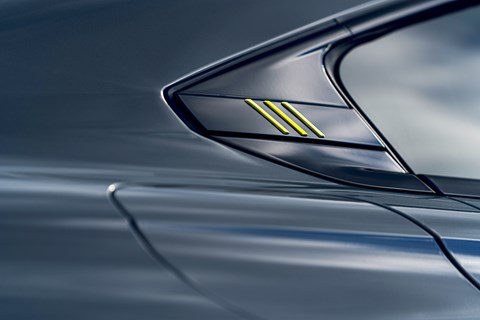
Which version is this?
The Sport Engineered is the top-tier 508 and sits above less powerful PHEVs and cars with performance styling but without much speed. You get loads of kit – a Focal stereo, massaging seats and 20-inch wheels, plus an aero-effect bodykit and Kryptonite accents. The estate (badged SW) is more practical and looks good too, although it costs almost £2000 more than our Fastback.
Read our Peugeot 508 Sport Engineered review
Pre-flight briefing: Volvo S60 Polestar Engineered
Why is it here?
The non-German premium alternative gives you a sleek exterior teamed with a cockpit that looks like a posh kitchen. The car feels fashioned from marble, from the heavy controls and door handles to the way it pummels mid-corner bumps with dampers you’d normally find on a superbike. A safe pair of hands with a wild side.
Any clever stuff?
Suspension by Öhlins, brakes by Brembo, dust caps and seatbelts by Polestar. The former has 22 clicks of compression and rebound adjustment to fine-tune the ride and handling – we’d recommend the softer end of their scale for UK roads. The ultimate in handling personalisation? Or just too tempting a prank to wind your friend’s left strut to its firmest setting and the right to its softest?
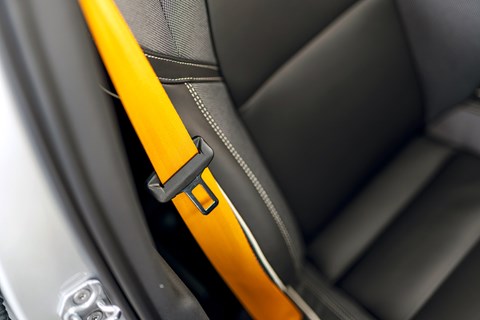
Which version is this?
The S60 Polestar Engineered takes the already powerful T8 R-Design and adds more poke and a sporty flavour – namely 19-inch wheels, gold calipers and black chrome exhaust pipes. Harks back to the far-out but brilliant V60 Polestar.
Read our Volvo S60 review
The cable guys: 508 PSE vs S60 Polestar Engineered
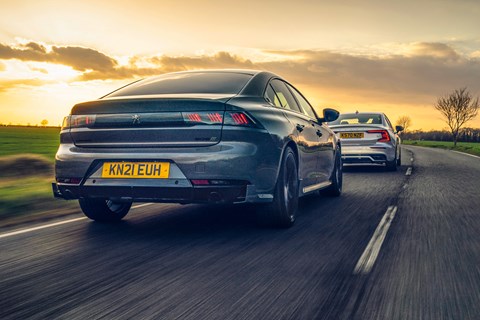
There’s a book in our house called Hamilton’s Hats, which is about a pig with an absurdly large headwear collection. I’ve read it to my son so many times I could recite it with my eyes closed. Open my skull and you’ll find it printed on my occipital lobe.
I bring this up because Hamilton’s on my mind even more so than normal while driving the Peugeot 508 Sport Engineered, a car with an equally over-abundant number of metaphorical hats. A sleek fastback, a business-class motorway cruiser, a zero-tailpipe-emissions penguin-pleaser and now, apparently, a powerful sports car too. That’s quite the CV.
Does that overcomplicate things? Most Sport Engineered 508s will be bought by company-car drivers, who you might think are easy enough to please – a posh badge to impress clients, an M Sport bodykit to impress colleagues and a low-overheads diesel engine to impress the fleet manager. Everything else is secondary.
Except that last assumption is now out of date. Plug-in petrol hybrids like this and the Volvo S60 T8 Polestar Engineered I’m on the way to meet offer high performance if you’re willing to plug in every night, and low tax bills even if you’re not. (Though both these cars cost north of £50,000 if you’re buying outright.) A battery-electric car could do both things better, but not everyone or everywhere is ready for that yet, so fast PHEVs like this Pug with a plug look like a good idea. For now.
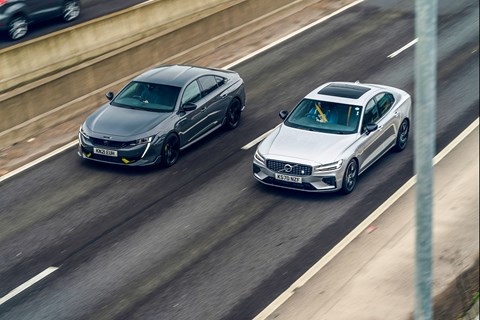
The plan is to do company-car-driver things today. My breakfast is a protein flapjack and a Costa Express from a petrol station. From there we’ll being driving to a ‘business meeting’ in central Cambridge, taking in a fast motorway cruise and then some pure electric miles in a city that would really rather we were on bicycles. Classic PHEV territory, then, and an opportunity for these plug-in hybrids to show themselves in their best light.
But these are no ordinary hybrids. They’ve been breathed on by performance experts, as indicated by their ‘engineered’ badges. So some after-hours driving on entertaining B-roads will also be required. Tough work, but someone’s got to do it.
Colleague Tom Wiltshire is a devout Peugeot fan who block-booked his diary to drive the 508, even though today is his mum’s birthday (sorry, Tom’s mum). I, meanwhile, love a fast Volvo, Öhlins suspension and anything with anodised dust caps, so my skin’s ready to have the S60 T8 get right under it. Between us, we’ll do our best to make sense of this mildly contradictory, very 2021 pair.
The 508 Sport Engineered is the most powerful roadgoing Peugeot to date, with a system total of 355bhp and 384lb ft on offer from the combination of a 1.6-litre petrol engine and two electric motors. The Volvo has a single e-motor but its bigger 2.0-litre combustion engine gives it 400bhp.
To my eyes the S60 looks superb, the best-looking car Volvo makes: compact, nice proportions, squat stance, clean lines. The Polestar additions only enhance this: fabulous 19-inch wheels, gold brake calipers, and high-gloss black on the grille and tailpipes.
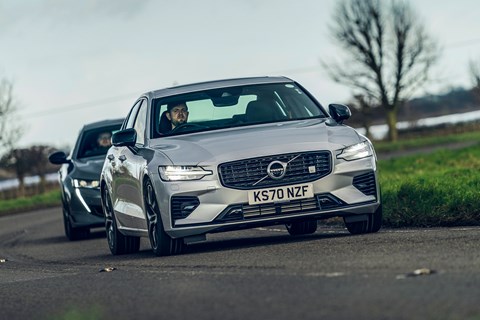
The Peugeot’s sporty bodywork is relatively subtle at a distance. It’s only as you get closer that things begin to pop out: the double-bubble roof, the aggressive diffuser and aero ducts on the front bumper, and the little vertical blades sticking up on the edges of both. Love them or loathe them, they all help stop the Peugeot looking and feeling like a German car. For many that’ll be a key part of its appeal. The three-claw motif is one of many Kryptonite Green additions to the 508’s bodywork, an eye-catching and attractive colour that’s reminiscent of the acid green Porsche was once fond of for its E-Hybrid badging. No bad thing. It also enhances what could be quite a sober colour scheme, given this 508 is available only in black, grey or white.
The 508 is all-wheel drive, as is the Volvo, though be still your beating heart – for the most part the four-wheel-drive system is there to improve grip in inclement weather rather than for emulating Ari Vatanen’s sideways-but-fast run up Pikes Peak in a 405 T16. The Peugeot’s two drive axles are also useful for transferring the car’s meaty output cleanly to the tarmac.
Sadly there are few opportunities to deploy the car’s peak output on the A1(M) as we make for Cambridge. But there is plenty of time to fiddle with the adaptive suspension, activate the massaging driver’s seat and pump bass-heavy music through the Focal stereo. All these niceties are standard and help give the Peugeot executive-club appeal, plus the latter means you don’t have to listen to the distant rumble from the Michelin Pilot Sport 4S tyres or the faint rustle of wind around the door mirrors.
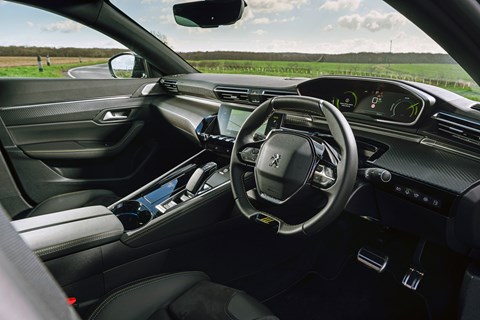
You need a bit more time to poke and prod at the Peugeot’s i-Cockpit interior than the Volvo’s trad cabin, simply because there’s quite a bit more going on: the tiny wheel set below the dials; the distinctive piano-key design in front of the 10-inch media screen; and the mix of carbonfibre-effect material and elephantine trim. It’s nicely styled and futuristic-looking in here, but there are some patches of hard plastic on the door bins and under the armrest that you don’t expect in a £50k car.
That complaint can also be levelled at the displays in the S60, which are starting to look dated in layout and resolution. The Volvo’s interior design is more restrained than the Peugeot’s. It just looks like a normal car – which, ironically, is quite brave these days.
The S60’s noisier and less comfortable on the motorway, largely down to that racy Öhlins suspension. The French car has a wider breadth of ability and its damping can be altered on the fly. You can adjust the Volvo’s suspension but access requires lifting the bonnet and, in some circumstances, jacking up the rear wheels. Can’t see many owners bothering, truth be told.
We’ve driven to Cambridge on ‘battery hold’ to save the maximum electrical range (26 miles in the 508, versus 27 in the Volvo) for urban driving. Before you start writing an angry email, I know that’s not the most efficient way to drive. That would be to put the destination in the sat-nav and let the car work out the best way to deploy the battery. But then we’d get here with no juice, and we’re keen to see what both cars are like wafting around town in EV mode.
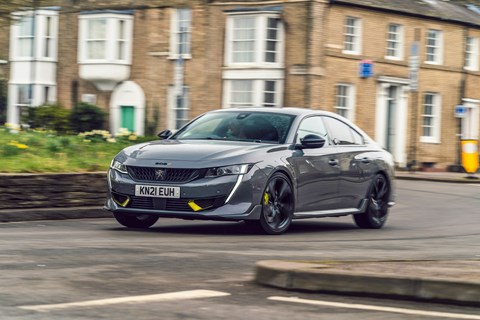
Of the Peugeot’s two motors, you mostly get the rear one in EV mode. The front, which is integrated into the gearbox, chips in every now and again to boost performance. That means the 508 feels more responsive as an EV but the margins are small, and during town driving it doesn’t feel like such a big advantage.
More useful is the Volvo’s extra range – we end up flattening the 508 in 18 miles, the S60 following later at mile 23. Bear in mind that many of those were hard yards, rather than consciously efficient driving. The Volvo feels firmer over road defects, missing out on that final degree of compliance offered by the adaptive suspension in the French car. It also feels heavier, its extra 205kg making itself known at low speed.
With batteries depleted we make for Cambridge Services for a top-up. Petrol power alone reveals a wider gulf in comfort – the Peugeot’s transmission remains smooth and unobtrusive while the Volvo’s eight-speed ‘box feels jerky. Less powerful Volvo PHEVs use a twin-clutch auto and, frankly, this feels like a step in the right direction (the S60’s too powerful for that ‘box). The T8 does sound good, though, with a gruff but purposeful rumble to the Pug’s reedy and over-synthesised tones (although the latter’s less annoying when you just want it to shut up and get on with driving).
Keeping both charged solves all of these problems, and that’s how they’re intended to be used. Both have batteries holding around 11.5kWh, and you can expect this to take about three to four hours to fill at their standard 3.7kW rate. You can pay extra for a 7.4kW charger in the Peugeot, dropping the time to one hour and 45 minutes, but that’s not available in the Volvo. That car also only comes with a three-pin cable as standard, which is no good if you’ve got a wallbox at home, while the 508 has only a Type 2, which is equally useless if you don’t.
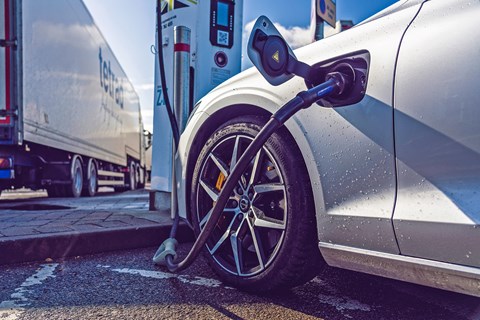
We’re at a public charger eating burgers, though, so it doesn’t matter, and this gives the cars about an hour to soak up as much charge as possible. This equates to roughly ‘a bit’ of electricity to use on the countryside corners we have our eye on between here and Peterborough – I’d like to be more accurate but both cars estimate the remaining electric mileage by factoring in your previous driving habits and, frankly, ours have been all over the place up to this point. Blame maddening Cambridge. And us (a little bit).
Battery power is required to unlock the full performance potential of these cars – the 355bhp the Peugeot offers and the 400 you get in the Volvo. While that looks like a healthy on-paper advantage for the Volvo, in practice it doesn’t translate into a yawning gap. Find the space to exercise it fully and the S60 does pull away. But you can certainly keep it in your sights without too much effort. On the straights at least. When it comes to a corner, these two take different approaches. The 508, remarkably, feels like a Peugeot Sport car – more hot hatch than saloon, with light controls, a little bit of bodyroll and an overall sense of agility and compliance that prioritises light-hearted enjoyment.
By contrast the Volvo is a muscle car, pure and simple. That much is clear from the way in which it urges you down a long straight, to the composed but slightly one-dimensional enthusiasm it displays for hooking up out of a bend. There’s even a distant whine that reminds you this engine is both turbo- and supercharged.
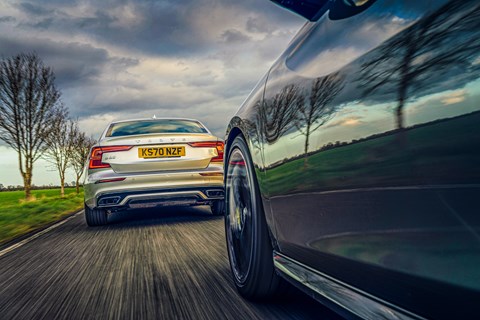
Polestar’s tweaks (the aforementioned Öhlins shocks, Brembos, lightweight alloys and software changes to the gearbox and steering) add up to a comprehensive overhaul of the S60’s handling. A front strut has also been installed to improve response on turn-in by reducing flex between the two shock towers. The level of grip it summons from its Continental PremiumContact 6s is huge. And it’s this that persuades you to push on in a manner that dispatches, rather than revels in, a string of sweeping bends.
The S60 T8 no longer steers like a Volvo, with better linearity and weighting (especially in small movements of the wheel) that brings with it the confidence to use the extra poke (up from 384bhp in the standard T8). Here the Öhlins suspension comes into its own, with better vertical control and the ability to shake off the kind of mid-corner bumps that would make the 508 shudder. In-town ride comfort is soon forgotten.
It also helps that the brake pedal has a good amount of feel – not so in the Peugeot, which is spongy and hard to get dialled into. The French car’s Alcon calipers and bi-material discs offer plenty of stopping power, no doubt, but the pedal lacks feel. The 508’s more neutral in a corner, though, and can be persuaded into a bit of lift-off oversteer as you’d expect in a car fettled by Peugeot Sport. The go-faster department’s adjustments include making the standard car lower and wider, as well as fitting model- specific springs, dampers and anti-roll bars. It’s the fun one, even if the Volvo’s arguably more effective and faster across country.
This time around it’s the Swede that runs out of battery first. Both cars are still capable without electrical assistance but you feel the suddenly reduced punch, and this remains the key constraint of a sporty PHEV. Like an F1 driver you have to manage your available energy.
It’s also why, over the course of the day, both cars return some 33mpg. In pure plug-in-hybrid terms that’s poor, but bear in mind the level of performance on offer and the fact that our testing was less efficient than normal driving. Regular daily use would garner a lot more; a pure petrol car with 300bhp+ likely a lot less.
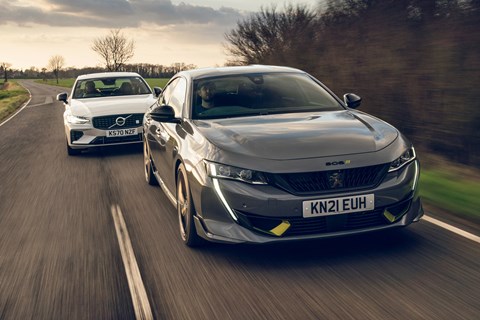
Second opinion: Tom Wiltshire, Bauer Automotive staff writer
Peugeot’s problem with anything fast is going to be comparisons with the iconic 205 GTI. It shouldn’t be. The 508 SE channels the spirit of cars like the 505 GTI – big, comfortable and handsome, but with an almost unnecessary amount of poise and response. It’s fun to drive, doesn’t let the Polestar get away, despite a substantial power deficit to the mighty Swede, and looks absolutely fabulous static or in motion. And like all the best French cars it’s a bit quirky, too, with its acid-green detailing and decidedly wacky driving position.
Second opinion: Jake Groves, CAR deputy news editor
Gorgeous looks, beautiful build quality and a crazily quick powertrain? What’s not to like about the S60? I’ll just say it: this variant. The regular T8 goes further on its battery and this car’s Öhlins dampers are simply unnecessary. They’re fantastic on the epic Polestar 1, but use the S60 for commuting and they’re far too jittery even in their softest setting. Curiously, Volvo offers the Polestar powertrain tweaks on non-Engineered variants without the trick dampers, and you can make an S60 T8 R-Design look just as lovely, too.
The final reckoning
An average fuel economy figure of 33mpg isn’t flattering for the fast PHEV concept, but neither is that figure the whole story. We saw an easy 40mpg in more measured use with regular charging, and you’ll get a whole lot more if – like so many these days – your driving is largely local. We’ve run plug-ins that haven’t touched a drop in weeks, and – if you can show some restraint – these two could do the same.
But there’s the rub. Is there not an intrinsic contradiction to adding batteries and electric motors to a combustion-engined car and then giving it a performance focus? Certainly few we’ve yet tested have squared that circle, including machines like the Skoda Octavia vRS iV (the non-vRS plug-in Octavia is a much more convincing product) and the oddball, less-than joined-up Cupra Leon.
The Peugeot gives away less in terms of outright practicality and comfort and is therefore, objectively speaking, the better car. The boot capacity is the same as a non-plug-in 508 at 487 litres, and because it’s a fastback it’s easier to access that load space than the Volvo saloon’s lesser 390 litres. The T8’s boot is also smaller than a front-drive S60’s and has a battery bulge in the floor, while the 508’s is flat.
Seat comfort aside (they’re just not comfortable), the Peugeot’s also the cosier car despite being way more fun and accomplished to drive than the standard 508. The S60 is crushingly competent on a twisty road but the price you pay is high, namely a lumpy ride in town and endless fidgeting on the motorway.
It can’t be ignored, however, that while Peugeot’s image is undoubtedly on a skyward trajectory, the S60 is in some ways the more appealing car. It feels the more mature product and a natural rival to the equally grown-up BMW 330e knee-jerk company car. The Volvo is also ferociously desirable. Handsome, rapid, beautifully wrought and in possession of a unique character, there’s a lot to fall in love with here, and to build a lasting relationship with.
The 330e still has the monopoly in the office car park (it’s a fast 3-series that costs peanuts per month, duh). But given the breadth of ability displayed by these two, its days at the top may well be numbered.
But really the biggest takeaway here is that unlike other too-many-hats PHEVs, which feel both confusing and confused, these two are genuinely great to drive without losing the benefit of zero-emissions miles. This is an odd niche, admittedly, but it’s one that deserves plugging. And right now, the first fast Peugeot in a long while does so very convincingly.
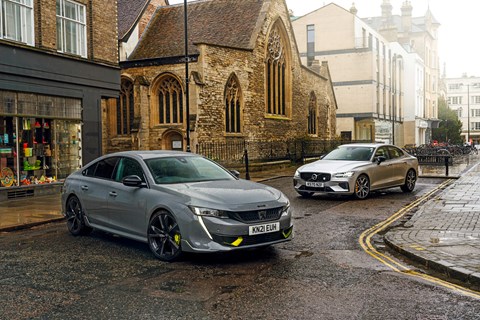
Peugeot 508 PSE vs Volvo S60 Polestar Engineered: verdict
First place: Peugeot 508 Sport Engineered
Speed, practicality and niche desirability – it can do it all, albeit at a price
Second place: Volvo S60 Polestar Engineered
Sleek, desirable and thumpingly fast but neither as agile nor as comfy as the Peugeot
Read more CAR comparison tests here